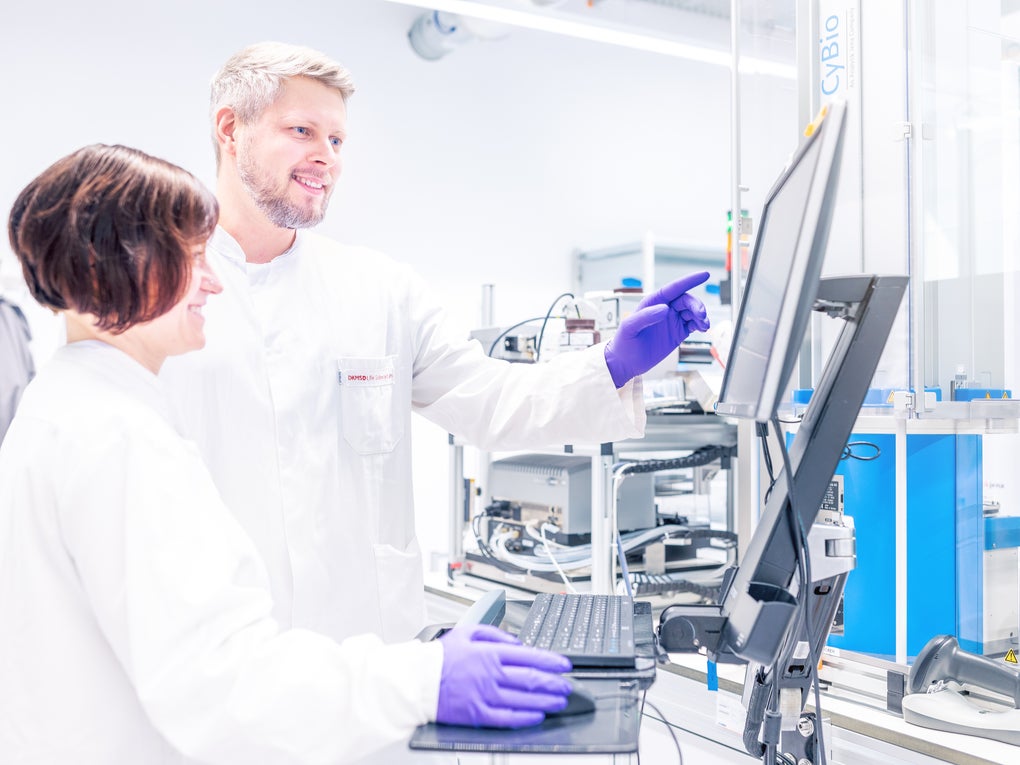
The Smart Lab for Second Chances at Life
Until recently, laboratories were characterized by a high proportion of manual work. But today, modern laboratories have a whole range of automation technologies at their disposal - from robotic assistance to the latest possibilities offered by computer-aided data analysis.
What Makes Our Laboratory Smart?
For a high throughput laboratory like ours, a manual process is not an option. Many work steps, such as pipetting DNA and reagents into the correct plate position, can be carried out by specially programmed robots that are not only faster but also more error-resistant than humans doing the same task. Individual sub-processes of our workflow can form so-called automation islands: A complex robot is loaded with prepared materials and can then independently generate a product for the next process step. DNA-plates can be created consistently, and picking the right sample for repetition out of hundreds is done in the blink of an eye. The digital master mind tracking all samples throughout the workflow is our LIMS (Laboratory information management system), connected to our database and equipped with the knowledge, the background, location and future of each sample. All in all, automation enables us to type 25,000 samples per week - that's more than a million samples per year! Even the occasional 30,000 samples per week do not require any adjustments.
But the true intelligence of our laboratory lies beyond the sophisticated robots: what makes them smart is ultimately the people who program them. One of our special features is the fact that nearly all robot programming is carried out by our very own employees. This allows us a high degree of flexibility, precise integration into our workflow with connection to LIMS and our databases and maximum convenience for users.
And even more extraordinary: some of our devices themselves are custom-made products that were developed with us and especially for us! Examples include our wonderful Swabster, our system for CMV status identification from swabs (the first of its kind!) and our hard-working DNA-isolation robot.
For us, state-of-the art technology does not stop with equipping ourselves with the latest off-the-shelf technology, but also that we do not shy away from unprecedented new developments for the benefit of efficiency and better quality.
Who Are the Robot Whisperers?
Nobody knows more about how our robots work and what they need to function flawlessly than our Lab Technology & Automation team! These versatile specialists are involved in the installation and maintenance of our devices and ensure that everything functions smoothly and in accordance with industry standards. From the planning of special cooling cells and continuous process control to the new and further development of robot programs and the connection to subordinate systems such as databases and LIMS: the tasks of a laboratory technician cover a wide range. To be able to do everything from conceptual design to programming, our automation specialists must have a high level of technical comprehension, IT affinity, communication skills and, of course, a real hands-on mentality.
And How Exactly Do We Know That Everything Works Just Fine?
A high-throughput typing workflow as complex as ours must not be left to its own devices. Who knows, if the temperature of the hydrocycler really is that stable? Or whether the read counts meet the expected standards? The laboratory engineers, of course! Everything that can provide us with valuable information about the quality and functionality of individual work steps is tracked and monitored systematically. The final results also provide valuable insights, as the CMV determination process shows. The monitoring of the position of the standards and controls in standard ranges and the quality of the standard curves as well as statistical characteristics of the measurement results of the samples allow a reliable statement on quality and reliability of results.
And of course, due to the complexity of interlocking processes, a great deal of documentation is required to avoid chaos and ensure our high quality standards. In accordance with the requirements of our DIN EN ISO 15189 accreditation for traceability and a controlled development process, all developments are mapped in a ticket system and go through a defined process with several approvals before going live. This requires some additional work, but brings enormous added value in terms of traceability and overview.
Are There Any Limits to How Smart a Laboratory Can Become?
In a world full of rapid developments, particularly in the field of robotics and artificial intelligence, it is difficult to predict what the future holds. To date, we have intentionally adopted the use of stand-alone automation islands. These are loaded manually, giving us a high level of flexibility and enabling different workflows to run on the same devices. In contrast, a fully automated production line would require highly specialized workflows, essentially restricting the line to a single, inflexible function.
While the automation of many work steps has already made our laboratory fit for the future and ready for new ventures, there is still a lot of human surveillance and manual work in the laboratory required, e.g. the careful loading of our robotic devices or the diverse tasks in sample receipt. Errors can also affect automatic monitoring systems, and the large number of different possible incidents makes automatic evaluation difficult in principle. Some kind of manual monitoring and evaluation will always be necessary, and no robot will be able to replace employees who, with their attentive minds and clever ideas, are the ones who ultimately shape the further development of our laboratory and make it special.